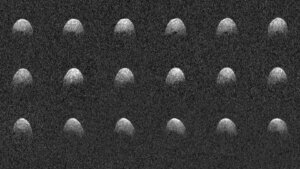This video is no longer available.
Right on time at 1:21 a.m. EST, NASA and SpaceX launched a planetary defense mission called DART — Double Asteroid Redirect Test — from California. The launch team only had a one-second window to launch for this attempt as the mission’s navigation requirements are so precise and tight to reach DART’s target, a double asteroid millions of miles from Earth.
The building of the DART spacecraft and managing the mission with a myriad other partners is our own Johns Hopkins Applied Physics Laboratory (JHAPL).
The DART spacecraft will fly to an asteroid named Didymus which has a small moon named Dimorphos, arriving in late September 2022. The spacecraft will impact the moon in order to change its orbital characteristics around the parent body, Didymus. The two asteroids DO NOT AND WILL NOT present a threat to Earth now or after the impact. This is the first space mission dedicated to planetary defense and will help humanity develop defenses against the very real threat posed by asteroid impacts.
Ten days before impact DART will deploy a briefcase-sized cubesat made by the Italian Space Agency that will trail DART by about 3 minutes flight time and provide imagery of DART’s impact via cameras named LUKE and LEIA (of Star Wars fame). DART’s onboard camera will provide imagery as well up until impact.
Seven million miles from Earth, as described by NASA, “The DART spacecraft will achieve the kinetic impact deflection by deliberately crashing itself into the moonlet at a speed of approximately 6.6 km/s (15,000 mph), with the aid of an onboard camera named Didymos Reconnaissance and Asteroid Camera for Optical navigation (DRACO) and sophisticated autonomous navigation software. The collision will change the speed of the moonlet in its orbit around the main body by a fraction of one percent, but this will change the orbital period of the moonlet by several minutes — enough to be observed and measured using telescopes on Earth.”

As explained in JHAPL’s briefing material,” Not only will DART give Dimorphos a healthy shove at the moment of contact, but the impact’s energy will excavate a crater and blast between 22,000 and 220,000 pounds of asteroid surface material, called ejecta, into space. The recoil “kick” from these ejecta on the asteroid could rival, or even exceed, the direct push from the DART spacecraft. It’s this enhancement in the asteroid’s momentum that makes kinetic impact a particularly attractive deflection technique, and measuring it accurately is a major component of DART’s mission.”
For DART to be considered a planetary defense success story, a minimum change in the orbital period of Dimorphos of 75 seconds must be obtained. Earth-based telescopes will be able to measure any deflection in the moonlet’s orbit around Didymos.
To get further data on the impact result itself the European Space Agency (ESA) will launch in Nov. 2024 a spacecraft called Hera to Didymos to study the impact site on the moonlet. The collected data will help refine our knowledge of asteroids and their moons — about 15% of currently known asteroids — as well as our planetary defenses against them. Hera will arrive at Didymos in 2026.
DART is an important mission to our planetary defense against asteroids that are discovered to be an impact threat to our planet. Asteroids as small as 65-feet across pose a significant threat as was proved in the Feb. 15, 2013 Chelyabinsk asteroid detonation over the city as 1,600 people were injured, a million square meters of glass broken. All the result of the equivalent of 600,000 tons of TNT exploding which is the equivalent of about 35 Hiroshima nuclear warheads. Oh, and we never saw it coming as it came out of the sky in the direction of the Sun.
The good news is that for the next 100 years, there are no KNOWN asteroids in the 140 meter and larger size that pose an impact threat to our planet and us. Note the emphasis on known.
The bad news is that humanity has only found 40% of the estimated 25,000 asteroids the size of Dimorphos (140 meters or over 1.5 times the size of FedEx Field) and a paltry .4% of the estimated 5 MILLION asteroids in the 25 meter and smaller Chelyabinsk impactor size.
Before you can deflect an asteroid threat you have to detect it.
A space based asteroid detection telescope named NEOWISE and a host of ground based telescopes search the skies constantly for asteroids. NASA is planning a mission called Near Earth Object Surveyor — NEO Surveyor — that will significantly up the number of asteroid detections
using a space based telescope positioned a million miles from Earth so that it can find asteroids all around the solar system. This should help alleviate any blind spots caused by the Sun. New very large ground based telescopes are due to become operational in a few years and will help in asteroid detection also.
We are at risk for asteroid impacts. It isn’t a matter of if……it is a matter of when as to another, and perhaps even more catastrophic Chelyabinsk event occurring.
Remember, the dinosaurs are dead because they didn’t have telescopes and a space program to detect and deflect their cosmic killer 65 million years ago. We can avoid their calamity if we develop a robust planetary defense. DART is a start.
Follow my daily blog at Whats Up The Space Place to keep up with the latest news in astronomy and space exploration. You can email me at skyguyinva@gmail.com.







